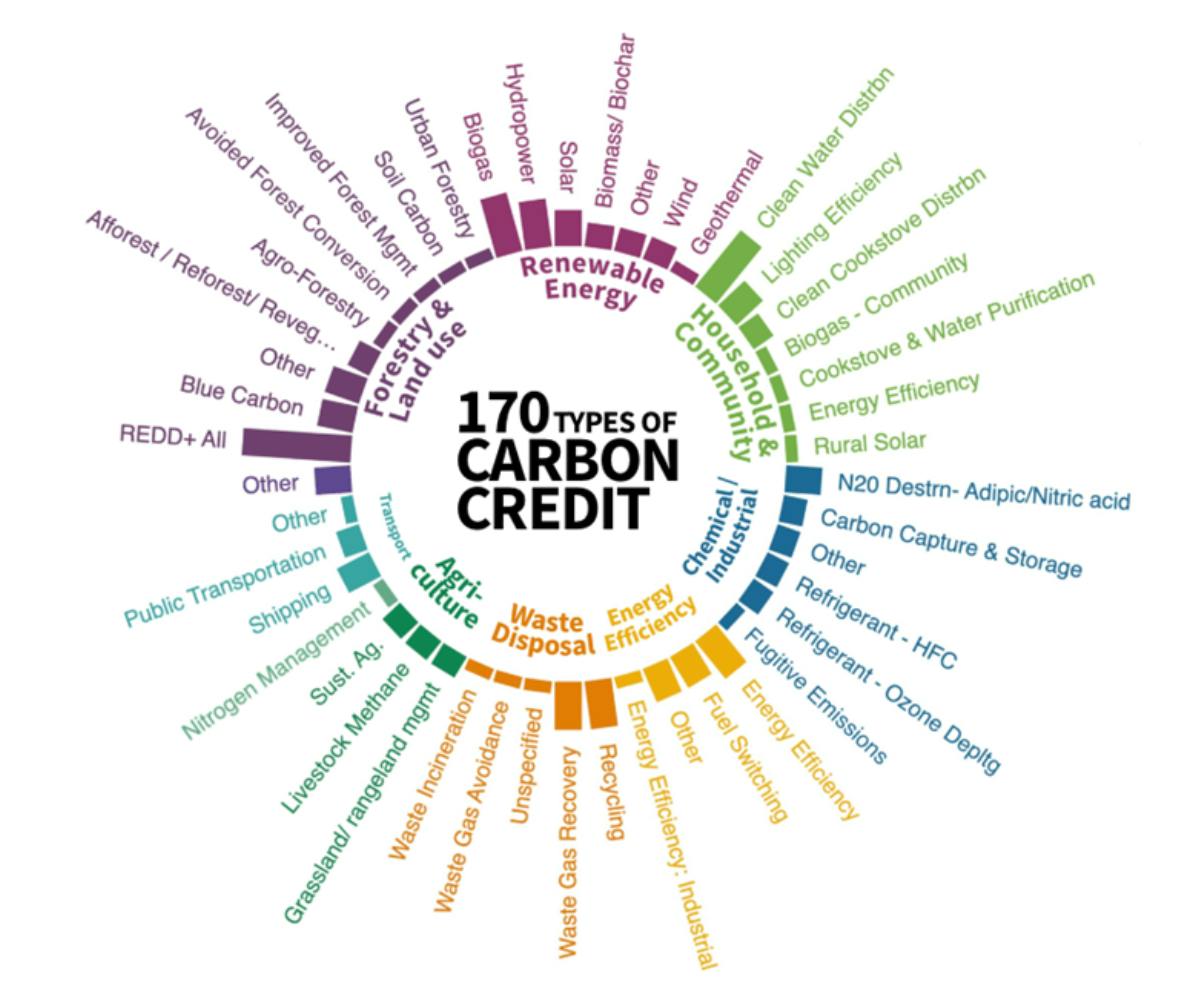
What are High-Quality Carbon Credits?
The Voluntary Carbon Market (VCM) offers a platform for companies, organizations, and individuals to voluntarily engage in climate action. Emerging in the 1990s, the VCM has evolved through the contributions of various stakeholders, including standards, initiatives, and NGOs like WWF, which established the Gold Standard in 2003.
The VCM's primary mechanism is Carbon Credits, representing one ton of CO2e avoided, removed, or stored from the atmosphere. These credits are generated through various climate projects, such as nature-based solutions, renewable energy, energy efficiency, and direct air carbon capture.
Content:
- What is the difference between ex-ante and ex-post Carbon Credits?
- Defining High-Quality Carbon Credits
- Classifications of Carbon Credits

What is the difference between ex-ante and ex-post Carbon Credits?
Ex-ante Carbon Credits are a type of Carbon Credit issued based on the projected future amount of carbon reductions, avoidances, or removals of a climate project. They are also called Planned Emission Reductions (PERs). Since these credits are issued before the actual reductions or sequestration take place, there is a level of risk and uncertainty. The anticipated carbon reductions or removals might not be fully realized due to various factors such as project failure, natural disasters, or inaccurate initial estimations. On the other hand, ex-ante credits can provide crucial funding for early-stage projects. By selling credits upfront, project developers can secure the necessary financial resources to start and implement their projects.
Ex-post Carbon Credits are issued based on actual, verified reductions, removals, or avoidances of greenhouse gases (GHGs) that have already occurred and have been verified by an independent third party. Thus, often called Verified Emission Reductions (VER). This verification process ensures that the claimed reductions are measurable, permanent, and have an immediate impact on climate change mitigation. Ex-post Carbon Credits are a direct representation of measured and confirmed impacts of mitigating climate change and are more reliable compared to ex-ante credits. Ex-post carbon credits play a crucial role in the global carbon market, providing a verified and reliable means for organizations to offset their emissions and support projects that contribute to climate change mitigation.
Defining High-Quality Carbon Credits
As Carbon Credits are the quantified impacts in tons of CO2e of climate projects, it isn’t surprising that some of the key requirements of high-quality Carbon Credits derive from the key criteria in climate projects.
High-quality Carbon Credits like climate projects are additional, verified by independent auditors, exclude double claiming, and have permanent positive implications to mitigate climate change.
To make them even more robust, Carbon Credits derived from OCELL’s climate projects also need to present the following to be considered high-quality:
- Immediate Impact: An ex-post Carbon Credit where the reduction, removal, or avoidance has already happened and is verified by an independent third party.
- No Leakage: The project and thus the Carbon Credit activity didn’t shift emissions to other or neighboring areas.
- Technology-driven: The unique Carbon Credit is technology-driven enabling measurable, reliable, and transparent impact with a public documentation in a registry.
- Robust Baselines: Use of conservative and accurate baselines and buffer pools to ensure the long-term impacts of the Carbon Credit.

Classifications of Carbon Credits
Besides the differentiation of Carbon Credits to be certified ex-post or ex-ante, there are also other classifications attached to Carbon Credits.
Based on Emissions Impact
Based on their net emissions impact, there are three types of Carbon Credits:
- Carbon Removal
Carbon removal credits represent actions that physically remove carbon dioxide (CO2) from the atmosphere. This can be achieved through natural processes such as Improved Forest Management (IFM), afforestation or reforestation, as well as technological solutions like direct air capture and storage (DACS), where CO2 is captured from the air and stored underground or used in products.
- Carbon Avoidance
Carbon avoidance credits are generated by projects that prevent or reduce emissions that would have otherwise occurred. This includes activities such as:
Renewable energy projects: such as wind, solar, or hydro power that displace fossil fuel-based energy generation.
Energy efficiency improvements: reducing energy consumption and thus emissions.
Methane capture projects: capturing methane from landfills or agriculture before it is released into the atmosphere.
Forest conservation projects: avoiding emissions through conserving forests.
- Carbon Reduction
Carbon reduction credits are associated with activities that result in a direct reduction of emissions compared to a baseline scenario (scenario without the project activities). This can include:
Industrial improvements: enhancing industrial processes to emit less CO2.
Transport optimization: improving logistics and transportation methods to reduce fuel use and emissions.
Switching to low-carbon fuels: such as replacing coal with natural gas or biomass.
Based on the Market
VER (Verified Emission Reduction)
Verified Emission Reduction (VER) credits, also known as Voluntary Emission Reductions, are Carbon Credits generated by projects that voluntarily reduce, avoid or remove greenhouse gas emissions. These credits are not regulated by international treaties but are verified by independent third-party auditors and are registered with standards such as the Verified Carbon Standard (VCS), Gold Standard, or American Carbon Registry (ACR). VERs are typically used by companies and individuals who want to contribute to climate action on a voluntary basis. Each VER represents one metric ton of CO2 equivalent reduced.
CER (Certified Emission Reduction)
Certified Emission Reduction (CER) credits are Carbon Credits issued under the Clean Development Mechanism (CDM) of the Kyoto Protocol. These credits are awarded to projects in developing countries that reduce greenhouse gas emissions. Each CER represents one metric ton of CO2 equivalent reduced. CERs are rigorously verified by the United Nations Framework Convention on Climate Change (UNFCCC) to ensure their authenticity and reliability. These credits can be traded and used by industrialized countries to meet their emission reduction targets under the Kyoto Protocol and by companies acting on the Voluntary Carbon Market (VCM).
Based on the Category of Climate Project
To differentiate Carbon Credits in more detail, it is possible to classify them according to the climate project type they are derived from. According to the Ecosystem Marketplace’s Project Typology, climate projects can be put into 8 categories and 170+ climate project types.
The 8 categories are:
- Forestry and Land Use
- Renewable Energy
- Household and Community
- Chemical/Industrial
- Energy Efficiency
- Waste Disposal
- Agriculture
- Transport

Source: Ecosystem Marketplace
Conclusion:
Choosing high-quality Carbon Credits is essential for achieving immediate and scalable impacts in voluntary climate action. High-quality Carbon Credits, such as ex-post credits, ensure that emission reductions are real, measurable, and certified under reputable standards. These credits not only help organizations and individuals voluntarily contribute to climate action but also drive investment into projects that support long-term climate goals and foster a more transparent and accountable carbon market.
Read more about
Carbon Credits here: Can Carbon Credits help Save the Climate?
Sabine Schneider
Senior Content Marketing Manager I Forest Green Communications
A lifelong forest lover, working in climate action since 2021.
